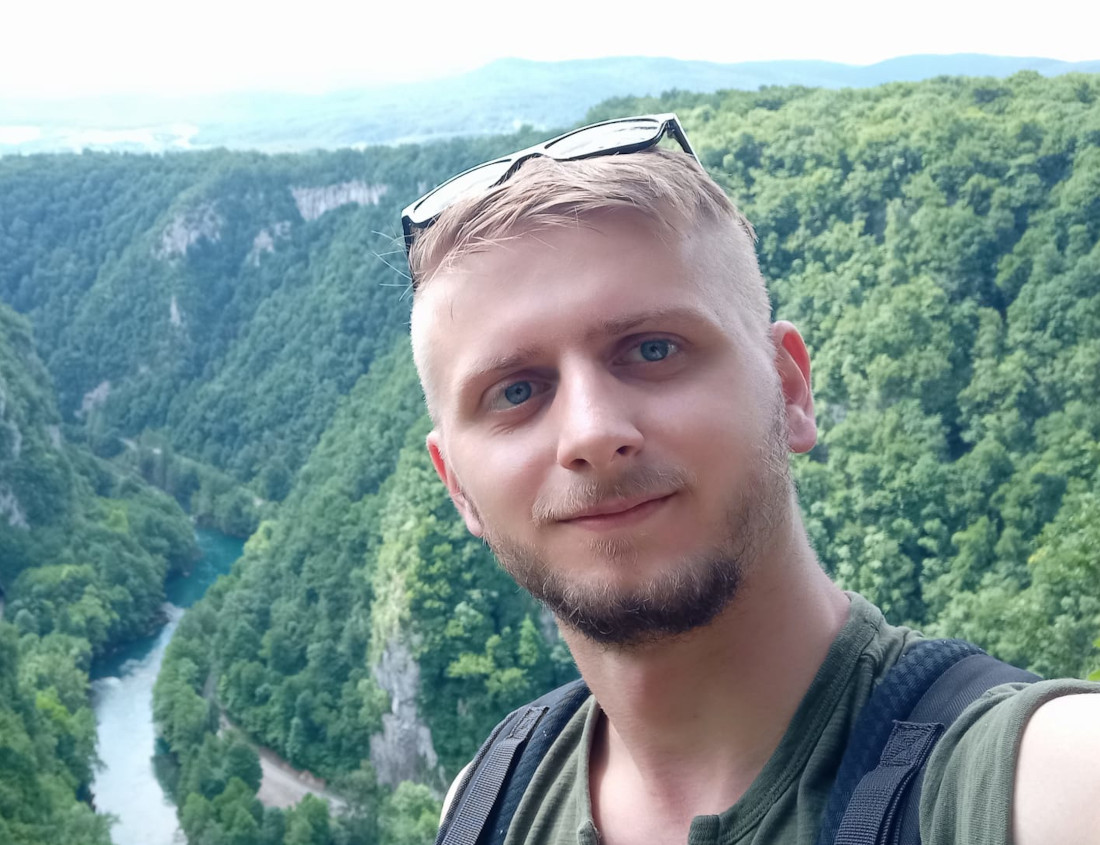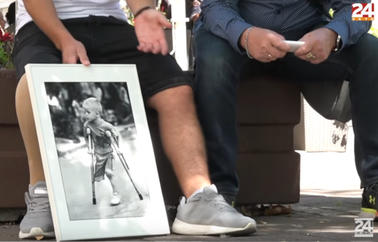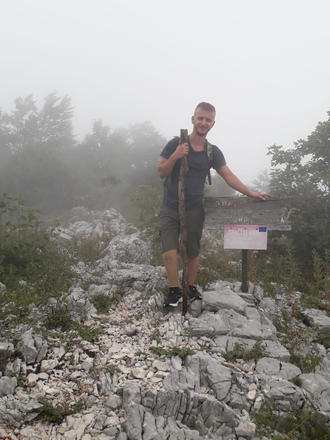Primo piano © photo Aladin Hodžić
Aladin Hodžić, now 32 years old, was hit by a grenade in 1994 and had his leg amputated. Thanks to a video-report made in 1995 by an Italian journalist, a solidarity network moved: he was welcomed in Italy to be treated and here he remained to live. We met him
In August 2022 the photojournalist Robert Belošević, after having already tried for years through a Croatian newspaper he began again to seek information on a child he had photographed in Bosnia and Herzegovina during the war. Aladin, that child, now an adult, saw the article thanks to social networks. The two met three months later, right in the place where the photo was taken [qui il video-reportage dell’incontro , realizzato da 24Sata, ndr]. But it is thanks to the reportage of another journalist, an Italian, that in 1995 Aladin Hodžić was welcomed and cared for in Italy.
Last summer the photojournalist Robert Belošević he sought information on the child without a leg that he had photographed during the war, to meet and get to know him. That child is you. Where were you when he took your picture?
It was August 1995 and he was a Croatian photographer who was following the war events linked to Operation Storm in neighboring Croatia but which also affected Bosnian territory. Bihać is my city, where I was born in November 1990 and where I lived, except for a short period in ’94 when my parents had sent me to stay with relatives, for safety.
It was there that I lost my leg in July 1994, while I was in Ostrožac, a village north of Bihać in the territory of the Cazin municipality. My father had decided to take me, together with my mother, to stay with my maternal grandparents where the situation was calmer, because a rather chaotic war period was ahead in the city of Bihać.
We stayed there for a few weeks, until I was injured. It all happened in the garden while I was playing with a dozen local children. From the surrounding positions they saw us and threw a grenade which fell a little far from us, but a shrapnel hit my right leg, while the other children were unharmed.
They immediately took me to the Ostrožac clinic for first emergency treatment and then immediately took me by ambulance to the hospital in Cazin, but as I was in serious condition I was transferred to Bihać where they amputated my leg. And then, I stayed in this city until I left for Italy.
It is thanks to a report by an Italian journalist that you arrived in Italy… What do you remember?
Yes, I arrived in Italy on 5 September 1995. I was 4 and a half years old and I don’t have many memories, but certainly the person who was most present and who helped us right from the start was Marco Beci who during the war in Bosnia worked for Italian cooperation, sadly died in 2003 in Iraq in the attack that took place in Nassiriya [a Marco Beci è dedicato il libro “Morire a Nassirya ”, uscito nel 2014, ndr].
I only remember a few images of the car journey to Italy, from Bihać to Zagreb and then from there to Budrio, in the province of Bologna.
I only came to know the details as I grew up. In addition to that photo, my story was publicly known thanks to footage taken by an Italian journalist, Luciano Masi of Rai who had followed the entire war in Bosnia and Herzegovina. Marco Beci, who worked for Italian government cooperation, saw those images on television and one day he showed up at our house in Bihać to tell us that without me he would not have returned to Italy. And so it was!
I left accompanied by my father, with Sanja, another 7-year-old girl, daughter of my father’s acquaintances, who had also suffered an amputation – in her left leg – due to a shrapnel from a grenade.
We were hosted in the first phase in the Municipality of Budrio, where we were given the first checks and medical tests, and the process for making the prosthesis was defined. Sanja and I did the same journey, same doctors, same hospital and subsequent rehabilitation period. The Budrio Prosthesis Center then continued to monitor the situation, also to “update” the prostheses that change gradually during growth in height and then also with weight gain.
Was the rest of your family in Bosnia? Did you then stay to live in Budrio?
My mother, with my little sister who was a few months old, joined us shortly after having obtained the documents together with Sanja’s parents. As soon as Sanja and I stabilized, my father decided that he no longer wanted to live on humanitarian aid. And so the question was to find a job, to stay and live in Italy, or to return to Bosnia.
At that point from the Municipality of Bondeno (province of Ferrara), twinned since 1982 with Bihać , the offer of a job and accommodation arrived and so we moved there. Today I live near Bondeno, with my wife and daughter and the rest of my family. While Sanja then moved with her family to Germany.
How did you find yourself in Italy? How is your life today?
Having arrived in Italy as a child obviously made the beginning of this new life easier, from learning the language to making new friends. Children learn quickly, I just need to look at my daughter who is still in kindergarten and she already speaks Italian, Bosnian and English!
Of course, it wasn’t a walk for my parents, who had to leave home and relatives in Bosnia and start from scratch, although they never let me weigh it. Obviously, on an emotional level it would have been easier for everyone to stay in Bosnia, where we had relatives and friends. But for my future, and considering the situation in the country still today, it was a real fortune to have been welcomed in Italy.
Today I have a job, a house and I live peacefully. I play sports, as a kid I really liked football while now I like hiking in the mountains and I’m attracted by “extreme” sports such as parachuting and bungee jumping (jumping rope or elastic rope).
Do you visit relatives and friends in Bosnia? How do you see your country, as a Bosnian and Italian citizen?
Of course, as soon as we can we will gladly return. I live Bosnia as an Italian and a Bosnian, that is, I feel both belongings are strong. So I see it through the eyes of a Bosnian, who feels an integral part of the country and its city, knows its language and traditions, but also through the eyes of an Italian citizen, let’s say “foreigner”.
So, I really like to go back, but at the same time I feel bitterness, anger and sadness seeing the situation. A small fraction of the population lives very well and got rich, while many other people live on the margins. So very high social differences. And it strikes me above all how they are left without the assistance to which people like me, victims of war, are entitled.
Comparing the help I had and which made it possible for me to build the life I have today, and theirs in which they did not receive the necessary material and psychological support, I am overcome with anguish. With everything that has happened during the war, the thousands of civilian casualties should be top of the country’s priorities. Instead they still remain, for level of assistance, last in Europe.
And then, I would like to add, when I’m in Bosnia I feel a lot of pain to see how much there are still people who incite hatred today. I understand that for those who suffered that war hard it is difficult to forget or forgive, but the new generations should at least be safeguarded from what we experienced and let them live in peace.
If we then count the economic crisis, the health care that doesn’t work, the corruption and the lack of work that drives so many to leave, I sadly have to say that it doesn’t even seem like a country that is part of the heart of Europe.
Have you thought about a subscription to OBC Transeuropa? You will support our work and receive preview articles and more content. Subscribe to OBCT!



